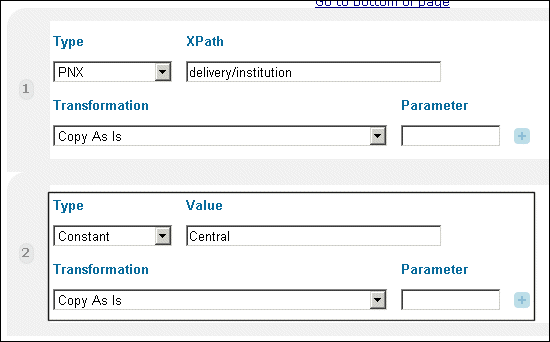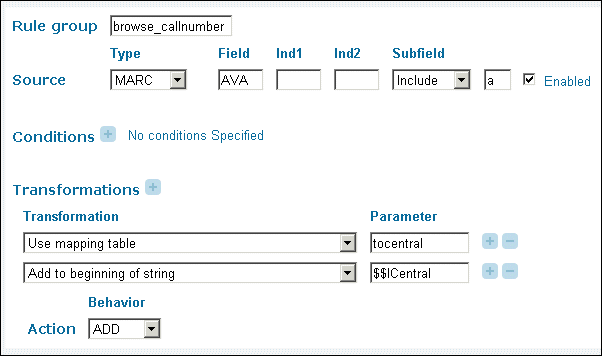Configuring the Normalization Rules for Browse
This section describes what Primo needs in order to build the browse lists.
The Browse Section of the PNX
The Browse section includes the following fields. The following table lists the contents of the Browse section.
| Field Code | Description |
|---|---|
|
institution |
The code of the owning institution. As noted above, the browse lists are created per institution. A single Browse section can belong to one or more institutions. During the Dedup process, the system appends the institution to every author, title, and subject. The call number should include the institution in the field itself because it is local by nature. If you want a combined browse list for all of your institutions, refer to Configuring a Cross-Institutional View. |
|
author |
Authors for the authors browse list. The author field should have several elements as described below. |
|
title |
Titles for the titles browse list. The title field should have several elements as described below. |
|
subject |
Subjects for the subject browse list. The subject field should have several elements as described below. |
|
callnumber |
Call numbers for the call numbers browse lists. The callnumber field should have several elements as described below. The callnumber field includes the institution in the field itself. If you want a combined call number browse list for all institutions, refer to Configuring a Cross-Institutional View. |
The heading fields (author, title, and subject) should have the following elements, each as a subfield. Note that only $$D and $$E are mandatory.
| Element | Description |
|---|---|
|
$$D |
Display form of the heading. |
|
$$E |
Normalized form of the entry for matching and sorting purposes. This is the key of the record that defines uniqueness. Most of the normalization is performed by the SE when the data is indexed. The normalization rules will remove leading articles only when this capability is enabled in the source data. |
|
$$P |
Preferred/non-preferred indication. The following values are valid:
In Browse, hypertext links are not supported for see also fields.
The system ignores the $$P subfield in Title fields. |
|
$$I |
Authority ID - $$I. This field is used for linking the preferred and non-preferred headings. This is not used in the title field. |
|
$$T |
Type of authority (subject field only). The out-of-the-box codes are derived from the following standards: You can include additional types. The display labels for the codes in the FE are defined in the Browse Labels code table, using the following format: default.browse.subjectype.<type>
For example: default.browse.subjectype.MESH
|
|
$$U |
Institution code. This subfield is used only in deduped records and is added automatically.
|
The call number field should have the following elements, each as a subfield. Note that only $$D and $$E are required:
| Element | Description |
|---|---|
|
$$D |
Display form of the call number. |
|
$$E |
Normalized form of the call number for sorting and matching purposes. This is the key of the record. |
|
$$T |
Type of call number. Currently the following types are supported (the code is based on the first indicator of the MARC 852 field):
Each of the above types are added to a separate browse list with a dedicated normalization procedure. Call numbers with a different type or no type are added to the generic list. |
|
$$I |
Institution to which the relevant holdings belongs. |
Normalization Rules Templates
Rules for the Browse section are available in almost all of the out-of-the-box templates, as described in the table below. For detailed information on the templates, see Mapping to the Normalized Record.
| Template | The Browse section |
|---|---|
|
Alma Marc |
Alma MARC records include the data for full Browse functionality. The rules added to the browse section create all possible subfields. In addition to the browse section, it is also necessary to update several other sections to ensure that non-preferred fields are not added. This is done by adding a condition that checks the preferred/non-preferred indicator to ensure that it is not non-preferred. This includes:
|
|
Aleph MARC |
Records published from Aleph v.21.1 (rep_change 002112) and v.20 (rep_change 003801) can include data for full Browse functionality. Note that some configuration is necessary in Aleph to ensure that all the data is extracted (refer to Aleph documentation). The rules in the Aleph MARC - Template template’s browse section has been updated to create all possible subfields for the Browse fields (from Primo V4.3). In addition to the browse section, it is also necessary to update several other sections to ensure that non-preferred fields are not added. This is done by adding a condition that checks the preferred/non-preferred indicator to ensure that it is not non-preferred. Since Aleph sends the non-preferred indicator in subfield P, it was necessary to exlcude this subfield in some cases. The following fields were updated to prevent creation of the field from non-preferred headings and/.or to exclude $$P:
|
|
Voyager |
Records published from Voyager 8.2.1 can include all of the data required for full Browse functionality. Note that some configuration is necessary in Voyager to ensure that all of the data is extracted (refer to the Voyager-Primo Integration Guide for more information). The rules in the Voyager - Template template's browse section has been updated to create all possible subfields in the browse fields (from Primo V4.3). In addition to the browse section, it is also necessary to update several other sections to ensure that that the non-preferred fields are not added. This is done by adding a condition that checks the preferred/non-preferred indicator to ensure that it is not non-preferred. Such a condition has been added to the following fields:
|
|
ALEPH MAB ALEPH UNIMARC |
For headings with no cross-references or authority type (for subjects), the system creates only $$D and $$E. Call numbers with no type are created from AVA/949. |
|
Generic MARC Unicorn SFX DigiTool MARC Generic UNIMARC |
For headings with no cross-references or authority type (for subjects), the system creates only $$D and $$E. Rules have not been added for the call number because it is not clear which tag can be used. It may be possible to add the rules locally. |
|
Generic Dublin Core Alma Dublin Core |
For headings with no cross-references or authority type (for subjects), the system creates only $$D and $$E. Rules have not been added for the call number since it is not clear which tag can be used. It may be possible to add the rules locally. |
Additional Data Needed from the ILS
Because all records that are harvested from the ILS include authors, titles, subjects, and call numbers, you can create browse lists in Primo for all ILS systems. However, there are some features in the Browse functionality that require additional information. If the ILS sends this information, the following functionality is also available:
-
Cross-references – Non-preferred headings are included in the author and subject lists with a link to the preferred heading.
-
Call number type – Separate lists per call number type (depending on their data some customers may be able to implement this even if this is not implemented by default).
-
Authority type – Display of the authority type for subjects.
Cross-References
The harvested record should include preferred and non-preferred headings in the same tag. The tag must include an indication if the entry is preferred or non-preferred. In order to create a link between the preferred and non-preferred headings, there also needs to be a subfield with the authority record ID from which the headings are derived (or some other unique code).
The following example is from Alma, but different subfields could be used for MARC.
<datafield ind1="1" ind2="" tag="100"/>
<subfield code="a">Miller, Rodney,</subfield>
<subfield code="c">violinist</subfield>
<subfield code="0">11-LIBRARY_OF_CONGRESS:n 81095936</subfield>
<subfield code="9">Y</subfield>
<datafield ind1="1" ind2="" tag="100"/>
<subfield code="a">Miller, Roddy,</subfield>
<subfield code="c">violinist</subfield>
<subfield code="0">11-LIBRARY_OF_CONGRESS:n 81095936</subfield>
<subfield code="9">N</subfield>
-
Preferred and non-preferred are in the same tag (100)
-
Subfield 9 is preferred/non-preferred indicator
-
Subfield 0 is the authority record Id to which both headings belong
Authority Type
In order to display the authority type for subjects, it should be included as a subfield rather than as an indicator, because it is very difficult to do this via the normalization rules. Note that if your site only has one or two authority types, you can do this locally.
In the following MARC example from Alma, the authority type has been added to subfield 2 as a code:
<datafield ind1="" ind2="0" tag="650"/>
<subfield code="a">Folk dance music</subfield>
<subfield code="z">New England.</subfield>
<subfield code="0">11-LIBRARY_OF_CONGRESS:sh 2009124441</subfield>
<subfield code="2">LCSH</subfield>
<subfield code="9">Y</subfield>
Call Number Type
The call number type used for the call number browse should represent the call number used to shelve the item. The call number type should be added to the tag from which the call number is derived.
In the following example from Alma, the call number is sent in the AVA field, and the type has been added to subfield k:
<datafield ind1="" ind2="" tag="AVA"/>
<subfield code="a">PRM50</subfield>
<subfield code="b">NAND</subfield>
<subfield code="c">Childrens Lit</subfield>
<subfield code="d">GT4905 .B7 1967</subfield>
<subfield code="e">available</subfield>
<subfield code="f">1</subfield>
<subfield code="g">0</subfield>
<subfield code="h">N</subfield>
<subfield code="i">0</subfield>
<subfield code="j">CLT</subfield>
<subfield code="k">0</subfield>
In the above case, the call number type is based on the MARC indicators for the 852 field.
Configuring a Cross-Institutional View
For each type of browse list (author, title, and subject), you must create a browse entry in the normalization rules for the “central” institution (which is the default institution for your cross-institutional view). In addition, you must ensure that the "central” institution is defined as a scope value and that it is added to all records.
For more information on “central” institutions, see the Primo Concepts, Components, and Relationships section in the Primo Back Office Guide.
Author, Title, and Subject Browse Lists
Add the following rule to the browse/institution field, entering the code of your central institution in the Constant field.

The constant Central used in the above example should be the name of your “central” institution.
Call Number Browse Lists
Duplicate all of the rules for the call number and then add an institution rule ($$I) that uses a new mapping table to convert all of the source institutions to your central institution. For example:

The constant Central used in the above example should be the name of your “central” institution.

